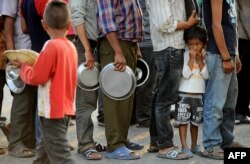South Asian countries will set up a toll-free helpline and online platform to fight human trafficking, which is growing on a massive scale in one of the world's poorest and most populous regions.
While some activists are hopeful this will curb cross-border trafficking, others doubt that it will dent the problem.
Although there is no specific data on the number of women and children trafficked in the region, the U.N. Office on Drugs and Crime says South Asia is the second-largest and fastest-growing region for human trafficking.
The main victims of trafficking are girls and women.
This week, Indian Home Minister Rajnath Singh underlined the need for regional solutions while attending a South Asia conference on protecting children.
After the conference, India, Pakistan, Afghanistan, Bangladesh, Bhutan, Sri Lanka, the Maldives and Nepal pledged to establish initiatives to trace missing children. They also plan to establish a uniform toll-free helpline and develop common standards for addressing sexual abuse, exploitation and trafficking.
Turmoil raises risks
Turmoil in several of these countries has led to a surge in trafficking, according to Colin Gonsalves, head of the New Delhi activist group Human Rights Law Network.
"Nepal has had the earthquake, Bangladesh has had political strife. So this area is an area where families are being unsettled and displaced, poverty has increased, and so there are very large volumes of trafficking in this area, and more important there is no check at all," he said.
There is high domestic trafficking in India also, where despite the impressive 7 percent-plus economic growth, huge income inequality means that millions of people are still extremely poor. At the same time, a surge in demand in the country's booming cities results in many children and women working as prostitutes, laborers and poorly paid domestic employees.
Many of the victims are brought from Nepal and Bangladesh into India.
‘Dismal situation’
A prominent Indian anti-trafficking activist, Rishi Kant, is optimistic that the South Asian initiative will curb cross-border trafficking.
"If we have [a] support system in other countries like Nepal and Bangladesh — because we have a lot of children from those countries coming to India, especially girl children — if those countries’ law enforcement agencies and the civil society jointly participate in passing information promptly and immediately, I think this will go a long way in rescuing the children," Kant said.
However, Gonsalves and other activists blame the governments and law enforcement agencies for only paying lip service to a very serious crime, and say trafficking rings continue to function with impunity.
"If you ask overall in South Asia, ‘Has there been any progress toward curbing trafficking?’ [The answer is] only cosmetic stuff, but no systemic attempt to stop trafficking. It's a very dismal situation," Gonsalves said.










